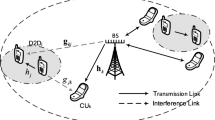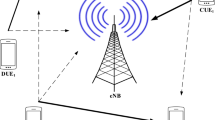Abstract
Device to device (D2D) communication that provides high data rate proximity based direct communication between users, along with simultaneous wireless information and power transfer (SWIPT) that extracts energy from the received RF power, can achieve high energy and spectral efficiencies together with low latency communication. Heterogeneous networks, that employ efficient frequency reuse, provide high gains in the coverage and capacity of the cellular networks. SWIPT helps in converting the harmful interference, incurred by the frequency reuse of D2D tier underlaying the Hetnet, into energy that can be stored for the future. This work presents a resource allocation and power control scheme for SWIPT enabled underlay D2D networks, designed to improve the energy efficiency and the amount of energy harvested while ensuring the minimum required data rates for the users. Resource allocation is performed using a stable many-to-one matching game model inspired from Gale-Shapley algorithm. Two techniques of SWIPT, namely power splitting SWIPT and time splitting SWIPT, are considered and the resource allocation schemes are designed for both. Simulation results demonstrate the superior performance of the proposed algorithm compared to an existing work in single tier network with power splitting SWIPT. The work is extended to a typical 5G HetNet scenario, and extensive simulations are done to compare the performance of the two SWIPT architectures in the HetNet scenario.













Similar content being viewed by others
References
Agiwal, M., Roy, A., & Saxena, N. (2016). Next generation 5G wireless networks: A comprehensive survey. IEEE Communications Surveys and Tutorials, 18(3), 1617–1655. Third Quarter.
Asadi, A., Wang, Q., & Mancuso, V. (2014). Survey on device-to-device communication in cellular networks. IEEE Communications Surveys and Tutorials, 16(4), 1801–1819. Fourth Quarter.
Mach, Pavel, Becvar, Zdenek, & Vanek, Tomas. (2015). In-band device-to-device communication in OFDMA cellular networks: A survey and challenges. IEEE Communications Surveys and Tutorials, 17(4), 1885–1922. Fourth Quarter.
Damnjanovic, A., Montojo, J., Wei, Y. T., et al. (2011). A survey on 3GPP heterogeneous networks. IEEE Wireless Communications Magazine, 10(3), 10–21.
Peng, M., Wang, C., Li, J., Xiang, H., & Lau, V. (2015). Recent advances in underlay heterogeneous networks: Interference control, resource allocation, and self-organizations. IEEE Communications Surveys and Tutorials, 17(2), 700–729. Second Quarter.
Perera, T. D. P., Jayakody, D. N. K., Sharma, S. K., Chatzinotas, S., & Li, J. (2017). Simultaneous wireless information and power transfer (SWIPT): Recent advances and future challenges. IEEE Communications Surveys and Tutorials, 20(1), 264–302.
Wang, F., Xu, C., Song, L., & Han, Z. (2015). Energy-efficient resource allocation for device-to-device underlay communication. IEEE Transactions on Wireless Communications, 14(4), 2082–2092.
Zhou, Z., Dong, M., Ota, K., Shi, R., Liu, Z., & Sato, T. (2015). Game-theoretic approach to energy-efficient resource allocation in device-to-device underlay communications. IET Communications, 9(3), 375–385.
Zhou, Z., Ota, K., Dong, M., & Xu, C. (2017). Energy efficient matching for resource allocation in D2D enabled cellular networks. IEEE Transactions on Vehicular Technology, 66(6), 5256–5267.
Orakzai, F. A., Iqbal, M., Naeem, M., et al. (2018). Energy efficient joint radio resource management in D2D assisted cellular communication. Telecommunication Systems, 69, 505–517.
Hoang, T. D., Le, L. B., & Le-Ngoc, T. (2015). Energy-efficient resource allocation for D2D communications in cellular networks. In Proceedings of IEEE international conference on communications, June 2015.
Morsi, R., Jamali, V., Ng, D. W. K., & Schober, R. (2018). On the capacity of SWIPT systems with a nonlinear energy harvesting circuit. Proceedings of IEEE international conference on communications, May 2018.
Luo, Y., Hong, P., & Su, R. (2017). Energy-efficient scheduling and power allocation for energy harvesting-based D2D communication. In Proceedings of IEEE Global Communications Conference (GLOBECOM) workshops, December 2017.
Gupta, S., Zhang, R., & Hanzo, L. (2016). Energy harvesting aided device-to-device communication underlaying the cellular downlink. IEEE Access, 5, 7405–7413.
Luo, Y., Hong, P., Su, R., & Xue, K. (2017). Resource allocation for energy harvesting-powered D2D communication underlaying cellular networks. IEEE Transactions on Vehicular Technology, 66(11), 10486–10498.
Kuang, Z., Liu, G., Li, G., & Deng, X. (2018). Energy efficient resource allocation algorithm in energy harvesting-based D2D heterogeneous networks. IEEE Internet of Things Journal 1–12.
Zhou, Zhenyu, Gao, Caixia, Chen, Xu, Chen, Tao, Zhang, Di, & Mumtaz, Shahid. (2017). Energy efficient stable matching for resource allocation in energy harvesting based D2D communication. IEEE Access, 5, 15184–15196.
Xiao, S., Zhou, X., Feng, D., Yuan-Wu, Y., Li, G. Y., & Guo, W. (2016). Energyefficient mobile association in heterogeneous networks with device-todevice communications. IEEE Transactions on Wireless Communications, 15(8), 5260–5271.
Apostolos, G., Konstantinos, K., Aikaterini, N., Foukalas, F., & Khattab, T. (2016). Energy efficient spectrum allocation and mode selection for mission-critical D2D communications. In IEEE conference on computer communications workshops (INFOCOM WKSHPS), April 2016.
Lohani, S., Hossain, E., & Bhargava, V. K. (2016). On downlink resource allocation for SWIPT in small cells in a two-tier HetNet. IEEE Transactions on Wireless Communications, 15(11), 7709–7724.
Gu, Y., Saad, W., Bennis, M., Debbah, M., & Han, Z. (2015). Matching theory for future wireless networks: Fundamentals and applications. IEEE Communications Magazine, 53(5), 52–59.
Gu, Y., Zhang, Y., Pan, M., & Han, Z. (2015). Matching and cheating in device to device communications underlaying cellular networks. IEEE Journal on Selected Areas in Communications, 33(10), 2156–2166.
Zhou, Z., Ma, G., Dong, M., Ota, K., Xu, C., & Jia, Y. (2016). Iterative energy-efficient stable matching approach for context-aware resource allocation in D2D communications. IEEE Access, 4, 6181–6196.
Dinkelbach, W. (1967). On nonlinear fractional programming. Management Science, 13(7), 492–498.
Gale, D., & Shapley, L. S. (1962). College admissions and the stability of marriage. American Mathematical Monthly, 69(1), 9–15.
O’Malley, G. (2007). Algorithmic aspects of stable matching problems. Ph.D. dissertation, Dept. Inform. Math. Sci., Univ. of Glasgow, Glasgow, U.K.
Author information
Authors and Affiliations
Corresponding author
Additional information
Publisher's Note
Springer Nature remains neutral with regard to jurisdictional claims in published maps and institutional affiliations.
Rights and permissions
About this article
Cite this article
Sreelakshmy, K.R., Jacob, L. Simultaneous wireless information and power transfer in heterogeneous cellular networks with underlay D2D communication. Wireless Netw 26, 3315–3330 (2020). https://doi.org/10.1007/s11276-020-02261-y
Published:
Issue Date:
DOI: https://doi.org/10.1007/s11276-020-02261-y




